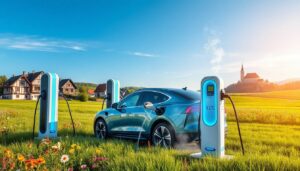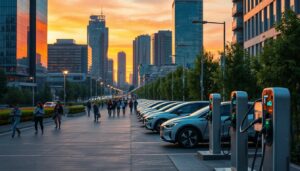Introduction
Electric vehicles (EVs) have taken the world by storm. Their rise is driven by the urgent need to cut emissions and create a cleaner environment. But, how quickly they are adopted depends a lot on where we are and who is in charge. Different areas—be it governments, industries, or cities—play key roles in shaping the growth of electric cars. This guide dives into the main areas of authority: government policies, car makers, renewable energy efforts, and urban planning. These factors impact how fast EVs reach more people and how they fit into everyday life.
The Role of Government Policy and Regulatory Frameworks in EV Adoption
Policy Incentives and Subsidies
Governments often give financial boosts that make EVs more attractive. Tax credits and rebates nearly double as prizes for switching to electric. For example, California offers rebates up to $7,000, spurring many to buy EVs. Norway leads with generous incentives—no import taxes, free parking, and even access to bus lanes—making EVs popular in Scandinavia.
Emission Regulations and Standards
Regulations on emissions push automakers to innovate. Rules like Euro 7 in Europe or California’s zero-emission vehicle (ZEV) mandate force manufacturers to keep up. These standards mean companies invest heavily in electric models. As a result, consumers see more options, and automakers stay competitive.
Infrastructure Development Policies
Creating charging stations is vital. Governments often work with private firms to build enough infrastructure. Think of it as adding more gas stations for EVs instead of gas-powered cars. Countries like the Netherlands have rolled out thousands of public chargers, making EV trips hassle-free. Local policies sometimes include dedicated zones where charging is mandatory or easier to access.
Local Government Initiatives and Urban Policies
Cities are stepping in with rules favoring electric rides. Urban areas are setting aside parking spots for EVs or creating zones where only electric cars can enter. Many cities now push for electric buses and taxis, reducing noise and pollution. For example, Shenzhen in China has converted its entire bus fleet to electric, setting a great example for urban transformation.
Automotive Industry Leadership and Innovation in Electric Vehicles
Major Automaker Commitments and Market Strategies
Big brands are pouring resources into EVs. Tesla remains a leader, aiming for larger market share with affordable models. GM plans to sell only electric vehicles by 2035, while Volkswagen heavily invests in electric lineup expansion. These shifts turn traditional car companies into electric champions.
Technological Advancements and Battery Innovation
Batteries hold the key to longer-range EVs at lower costs. Major breakthroughs include solid-state batteries that last longer and charge faster. Companies like QuantumScape are leading the way. Also, super-fast charging tech makes long trips easier. These innovations excite consumers and pave the way for wider adoption.
Industry Challenges and Competitive Dynamics
Supply chain issues slow down the EV race. Shortages of rare earth materials and semiconductors create bottlenecks. Startups are competing fiercely with established automakers, pushing for innovation. This ongoing rivalry sparks better features, lower prices, and more choices for buyers.
Consumer Acceptance and Market Trends
People’s willingness to switch varies by region. In some places, EVs are seen as eco-friendly status symbols, while others view them as costly or unreliable. Cultural factors, charging options, and local policies influence the rate of adoption. Overall, interest in EVs is growing, but it’s a gradual change.
Integration of Renewable Energy and Smart Grids in EV Ecosystems
Renewable Energy Adoption in Regions of Authority
Many regions encourage renewable energy to power EV charging. California, for example, links EV growth to its clean energy goals. This way, electric cars truly become part of a sustainable plan, not just a shift from fuel to electricity.
Smart Charging and Vehicle-to-Grid (V2G) Technologies
Smart chargers adjust when and how EVs charge. They can reduce strain on the grid during busy times. V2G tech goes a step further, letting EVs send power back to the grid when needed. Pilot programs are testing these ideas in places like Denmark, aiming to make energy use more efficient.
Challenges in Energy Infrastructure and Grid Capacity
As millions switch to EVs, energy grids face new stresses. Upgrading systems, managing peak loads, and ensuring stability is vital. Local authorities should plan ahead—adding renewable sources, boosting capacity, and encouraging smart grid solutions to handle the surge of electric vehicles.
Urban Planning and Infrastructure for Electric Vehicles
Development of Charging Infrastructure in Urban and Rural Areas
Spread-out charging stations can be tough, especially in rural regions. Planners must ensure chargers are placed in all neighborhoods, not just city centers. Strategic placement, such as parking lots and highways, makes EV use easier everywhere.
Impact on Public Transportation and Last-Mile Solutions
Electrifying buses and taxis cuts urban pollution. Cities like Los Angeles now operate large fleets of electric buses, reducing air pollution significantly. EVs are also leading the charge in delivery services, where quiet, emission-free rides are a must in busy city streets.
Sustainability and Environmental Impact
More EVs on the road mean cleaner air and healthier urban environments. But, urban planners have to consider sustainable development—like green construction and eco-friendly materials. Combining EV growth with smart urban design can make cities more livable and green.
Future Outlook and Strategic Recommendations
Emerging trends include autonomous electric vehicles and shared mobility solutions. These can make transportation more affordable and eco-friendly. For policymakers, industry leaders, and city planners, the focus should be on building better infrastructure, supporting innovation, and creating fair regulations. This will make EVs accessible to more people and faster to adopt.
Conclusion
Electric vehicles are shaping the future of transportation. Success depends on regional policies, industry innovation, and smart planning. Every area—government, business, or city—has a role to play. When these efforts align, EVs can make transportation cleaner, cheaper, and more convenient. The key is working together for a sustainable future. Electric cars aren’t just a trend—they’re a crucial step toward a greener world.




